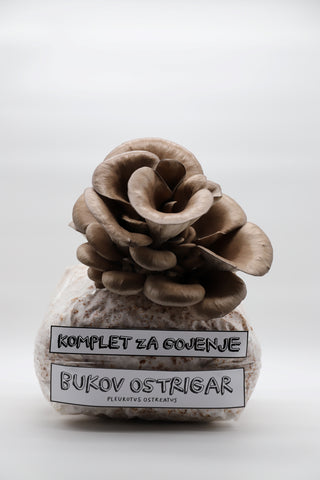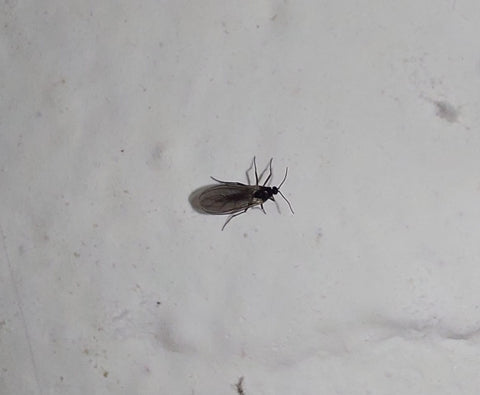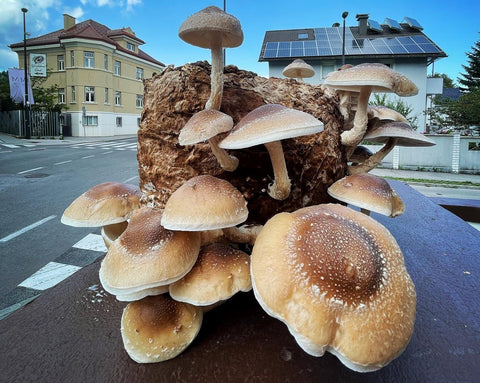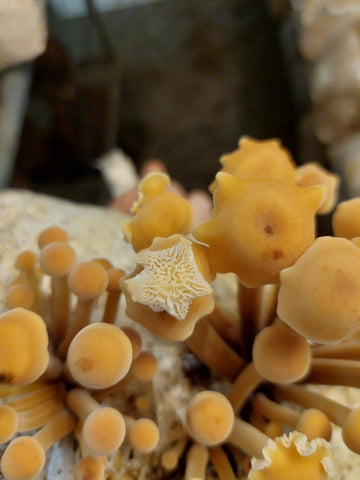Mushroom cultivation kits consist of a sawdust-based substrate overgrown with mushroom mycelium. The mycelium breaks down the wood and extracts nutrients and energy from it, which it uses for the development and growth of the mushrooms. You can expect up to one and a half kilograms of mushrooms from one set. Mushrooms will grow in multiple crops, usually 3x, but if you are persistent enough, it can be multiple times. The first two harvests are the largest, and the later ones are smaller and smaller in terms of the amount of mushrooms.
How to take care of the kits?
The most important factor for mushroom growth is sufficiently high air humidity, which should be at least 75%. Most mushrooms also need adequate ventilation and temperatures between 15 and 20 °C. Sufficiently high humidity and a sufficient amount of air can be ensured in two ways:
- Place the set in a room that is already moist. If you have a damp basement or similar area, this is sufficient for mushroom growth.
- Place the grow kit in a plastic box of larger dimensions (e.g. 40d x 30w x 30h cm or more). Before that, fill the bottom of the box with material that retains water (perlite, vermiculite, alumina, different types of sand). Wet the material and place the growing kit on it. Once or twice a day, spray the walls of the box with water, and also make sure that the material at the bottom of the box is constantly moistened. Place the box prepared in this way in a place where there is at least some light, but prevent direct sunlight from shining on the set. Do not close the box, but you can place a cloth or similar breathable material over it.



Tips
- Never spray water directly on mushrooms because they can start to rot.
- It is recommended to soak the set in water between one and the other crop. Place the kit in a bucket of water and weight it down so that it is as submerged as possible. Soak for 12 to 24 hours. This will re-moisten the substrate, which will encourage mushroom growth.
- When you think you've picked most of the mushrooms, don't take the set; remove the plastic wrap and place it in a shady outdoor location. Mushrooms often sprout several times when the external conditions are suitable for their growth.
Detailed instructions for individual kits
Beech oystercatcher

Make 1-4 incisions in the shape of a 5x5 cm cross in the bag, from where the mushrooms will grow; one hole results in one large bunch of mushrooms, and multiple holes in several smaller ones, with yields independent of the number of holes.
When you make the holes, squeeze out the excess air from the bag at the top and firmly glue the upper part of the bag to the lower part, so that we get a compact formation without air pockets - we want the mushrooms to grow where we determine for them (cut holes) and not where they have oxygen (all over the top of the bag).
Optimum humidity: 85-90%
Optimal temperature: 10-21 °C
Fringed mustache
 Make 1-4 incisions in the shape of a 5x5 cm cross in the bag, from where the mushrooms will grow; one hole results in one large bunch of mushrooms, and multiple holes in several smaller ones, with yields independent of the number of holes.
Make 1-4 incisions in the shape of a 5x5 cm cross in the bag, from where the mushrooms will grow; one hole results in one large bunch of mushrooms, and multiple holes in several smaller ones, with yields independent of the number of holes.
When you make the holes, squeeze out the excess air from the bag at the top and firmly glue the upper part of the bag to the lower part, so that we get a compact formation without air pockets - we want the mushrooms to grow where we determine for them (cut holes) and not where they have oxygen (all over the top of the bag).
Optimum humidity: 85-90%
Optimum temperature: 10-21 °C
King oyster
 The upper edge of the bag (5 cm) is cut horizontally along the entire width of the bag, so that the substrate reaches oxygen, and at the same time, in this way, the edges of the bag still help retain moisture a little.
The upper edge of the bag (5 cm) is cut horizontally along the entire width of the bag, so that the substrate reaches oxygen, and at the same time, in this way, the edges of the bag still help retain moisture a little.
We move the set to the growing environment and pay particular attention to the appropriate humidity.
Optimum humidity: 85-90%
Optimum temperature: 13-18 °C
Reishi or luminescent semicircle

Mushrooms can be grown in two ways: in a closed bag or like other mushrooms with an open bag in a suitable environment.
Cultivation in a closed bag is the simplest for home use, as we just place the bag in a bright and warm location, and we do not need to moisten it, as the moisture inside the bag is sufficient. When the mushrooms have grown to the top of the bag, open it just below the var, collect the mushrooms and close the bag back with adhesive tape, so it will do at least one more crop.
Optimum humidity: 80-85%
Optimal temperature: 18 -28 °C
Shiitake

With shiitakes, the entire substrate is taken out of the bag and placed in the growing environment, where the most important thing is to maintain high humidity, so that the mushroom embryos are formed to the greatest extent, which is most easily achieved by regular spraying on the substrate, so that the surface is always moist. Soon the substrate will crack and mushroom sprouts will appear there. When the mushrooms measure an average of 3 cm, we stop spraying the substrate so that the mushrooms do not start to rot, but we still maintain high air humidity in the environment where they grow.
After picking all the mushrooms, the substrate rests in the growing area for about a week, then the entire substrate is soaked in water (weighted so that it is completely covered with water) for 24 hours and then moved back to the growing area. The process is repeated until the mushrooms grow, we can expect at least 3 harvests.
What can go wrong when growing mushrooms from kits?
Mushrooms are living organisms that need suitable conditions for their life. If they do not have these conditions, problems will arise in their growth. But sometimes, despite doing everything right, problems arise.
Long hats and little betas
The reason for the deformation of mushrooms is insufficient fresh air or rather too much carbon dioxide. Indeed, many fungi are sensitive to the concentration of CO2 in the air , which can be seen in changes in the shape of the mushrooms that sprout from the cultivation kit. Due to the excessive concentration of CO2, the mushrooms become stretched and puffy. The length of the beta is greatly increased, while the size of the hats is reduced. The texture of the mushroom also changes, being much softer. Fringe warblers and all types of oysters are sensitive to the amount of CO2, while the shiitake is almost unaffected by the amount of CO2 . In certain species, such as winter hornbeam (enoki-take, lat. Flammulina velutipes ) or luminous reishi (reishi, lat. Ganoderma lucidum ), however, the change in the shape of the mushroom due to large amounts of CO2 is desirable.
Solution : it is necessary to increase the ventilation of the room where the mushrooms grow. Most often, problems arise when you grow mushrooms in closed or partially closed boxes. We recommend that you leave the box in which the mushrooms are growing open, and ensure air humidity by regularly spraying with water and placing at least a 5 cm thick layer of clay loam, perlite or vermiculite at the bottom of the box to moisten it well.

I wait and wait, but nothing grows
Mushrooms are sometimes stubborn and do not sprout immediately, and there can be many reasons for this. It is important to adhere to the conditions specified for the specific species, with temperature and humidity being the key. For example king oysters do not grow above 18 °C and you will wait for them in vain. Also fringed warts will not grow at temperatures lower than 8 °C . As for humidity, it is necessary to ensure at least 85% air humidity for most species. If you make a hole in the bag with the substrate, then the substrate at the place of the hole dries out due to too low air humidity , the mushrooms will also not grow. We would also point out beech oysters , which sometimes do not sprout immediately. Usually, mushrooms start to sprout from the grow kit within a week of making a hole in the pot, but not always. According to the reports of various customers and also our experience, they sometimes take up to a month before they sprout. So, if the beech oysters don't take off right away, patience is key. But they will certainly run.
Solutions :
- Considering the conditions (temperature and humidity) that different types of mushrooms need to grow.
- Patience.
The mushrooms sprouted, but later failed
As mentioned, temperature conditions have a crucial influence on the growth of mushrooms. Too high a temperature is usually responsible for the collapse of mushrooms that have already sprouted, but later started to turn brown, rot or dry. Warm air often also means drier air. If we remember elementary school physics, we know that warmer air can absorb a greater amount of (air) moisture. While quite a few types of mushrooms do not grow at too high temperatures (e.g. king oysters and black pearl oysters), here we would highlight mainly problems with fringed beards . Namely, they start to grow normally at temperatures above 22 °C, but it often happens later they turn brown and begin to decay . They are also more common at high temperatures contaminations that appear on the substrate, and are also more common bacterial infections (especially if the mushrooms are wet from spraying), which cause the mushrooms to rot. If this happens to us, we collect all the damaged mushrooms in their entirety and wait for new ones to grow. We never eat rotten mushrooms or mushrooms with brown spots, as they can be harmful to our health.
Solution :
- When the mushrooms are larger than 1 cm, stop spraying them with water. Stagnation of water on growing mushrooms is the most common reason for rot. To increase air humidity, spray only the walls and bottom of the box in which they are grown.
- If we have mushrooms in a room that is warmer than 22 °C (this does not apply to summer and pink oysters), find a cooler place for them. We monitor the air humidity and increase it if necessary.

Midges
Sooner or later, in a growing environment where we have bags of mycelium, midges appeared . Even in commercial mushroom farms, midges are the most common pest. Death flies are the most common, and they also often appear in the soil of indoor plants. The midges themselves do not cause damage to the mycelium, but their larvae (tiny transparent worms) do, which feed on the mycelium. Apart from insecticides, we don't have a really effective solution against midges that live on mushrooms, but there are quite a few preventive measures.
Solution :
- Installation of sticky traps (yellow plates or sticky tapes).
- Installation of traps in which flies get caught and drown. You can make such a trap yourself from a water bottle. As bait, we can use yeast dissolved in water and add a little apple cider vinegar.
- Traps with UV light.
- Electric vaporizers against mosquitoes. These contain a mild volatile insecticide. Death flies are very sensitive to insecticide in vaporizers. We install an evaporator in the room where we grow mushrooms for a few days. We would like to point out that the vaporizer has an effect only on adult midges, while it has no effect on larvae.

Dead flies are about 2 mm in size and black in color. Their larvae live in the substrate where they feed on the mycelium.
What if our grow kit gets too dry?
This does not happen often with substrates that are sealed in bags, but they do for drying the much more sensitive shiitake , which is grown without a growing bag. When growing shiitake, we recommend soaking the substrate in water for 12-24 hours after each harvest. Weight it down so that it is completely submerged. Even the sets in the bags will not be harmed if you soak them in water after the 2nd or 3rd cycle. For these, it is sufficient if you place them in 10 - 15 cm of water with the hole facing down, also for 12 - 24 hours. If we are not sure how much the substrate has dried, we can weigh it. Our grow kits weigh between 3 and 4 kg. If it weighs less than 2 kg, this is an indication that you should soak it. In any case, additional irrigation will encourage the growth of new mushrooms.

The mushrooms have grown, but they have strange shapes
Sometimes deformed mushrooms or mushrooms of unusual shapes grow out of the substrates. We have already described the change in the shape of mushrooms caused by the increased amount of CO2, but other factors also affect the shape of the mushroom. Sometimes it happens as if the tympanic membrane wraps around and pushes on the top of the hat, bumps can appear on the hat. When growing mushrooms, we noticed that king oysters and black pearl oysters are prone to this. This is also reported by other breeders, so we believe this is normal for these two species. We also found that summer oysters become deformed at temperatures below 15 °C. The reasons for deformations can be very different, such as water stagnation on the caps, unsuitable conditions for growth, (too) old mycelium, fungal viruses and others. Despite the fact that the mushrooms have strange shapes, you can use them normally (if they have a normal smell and no brown spots).


